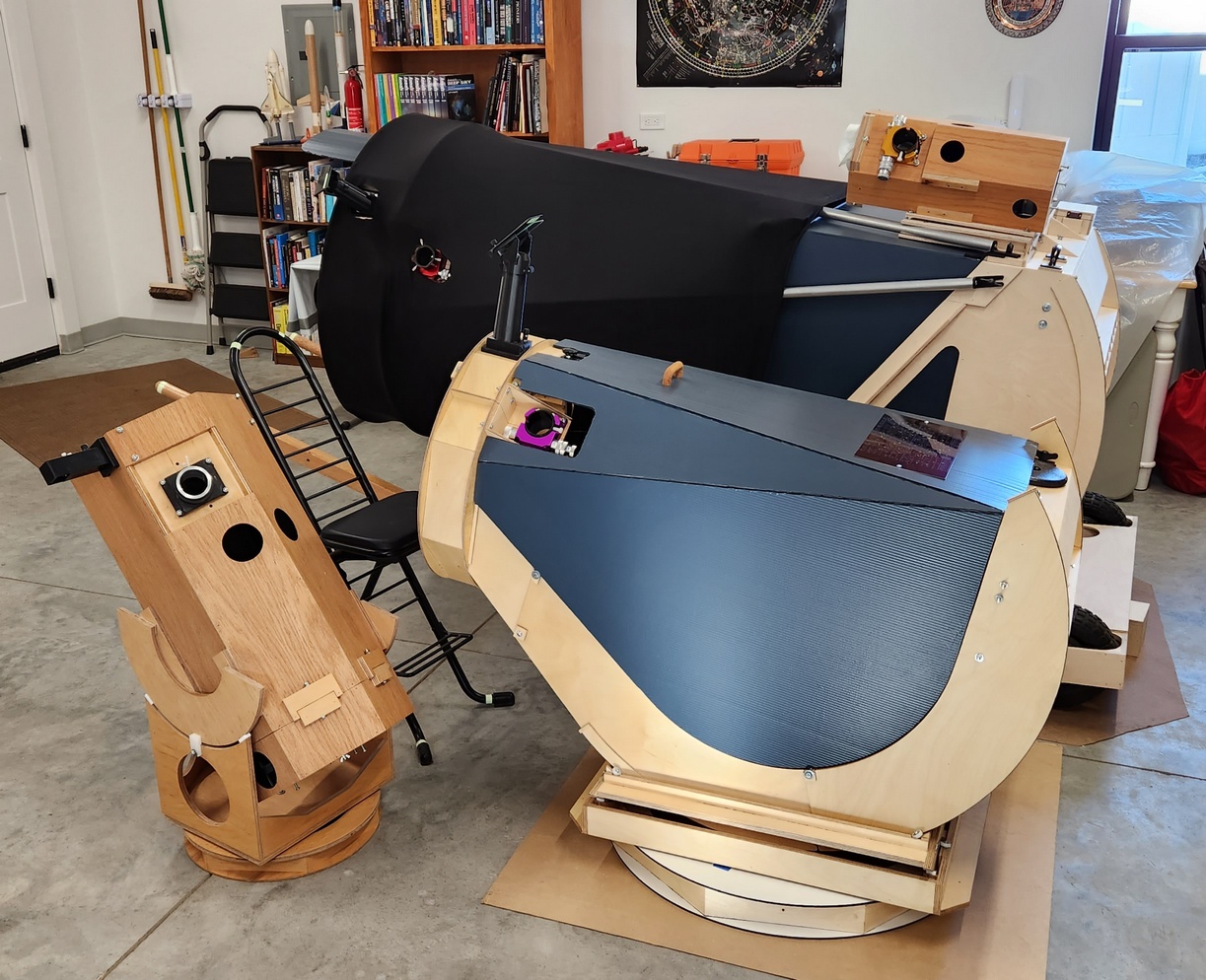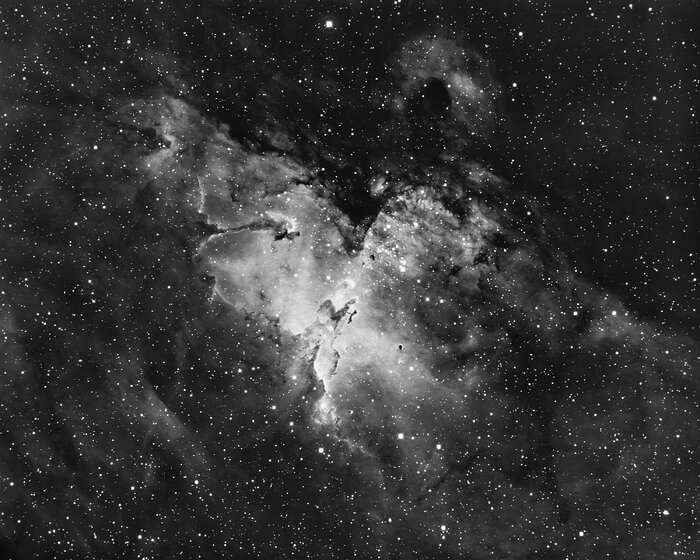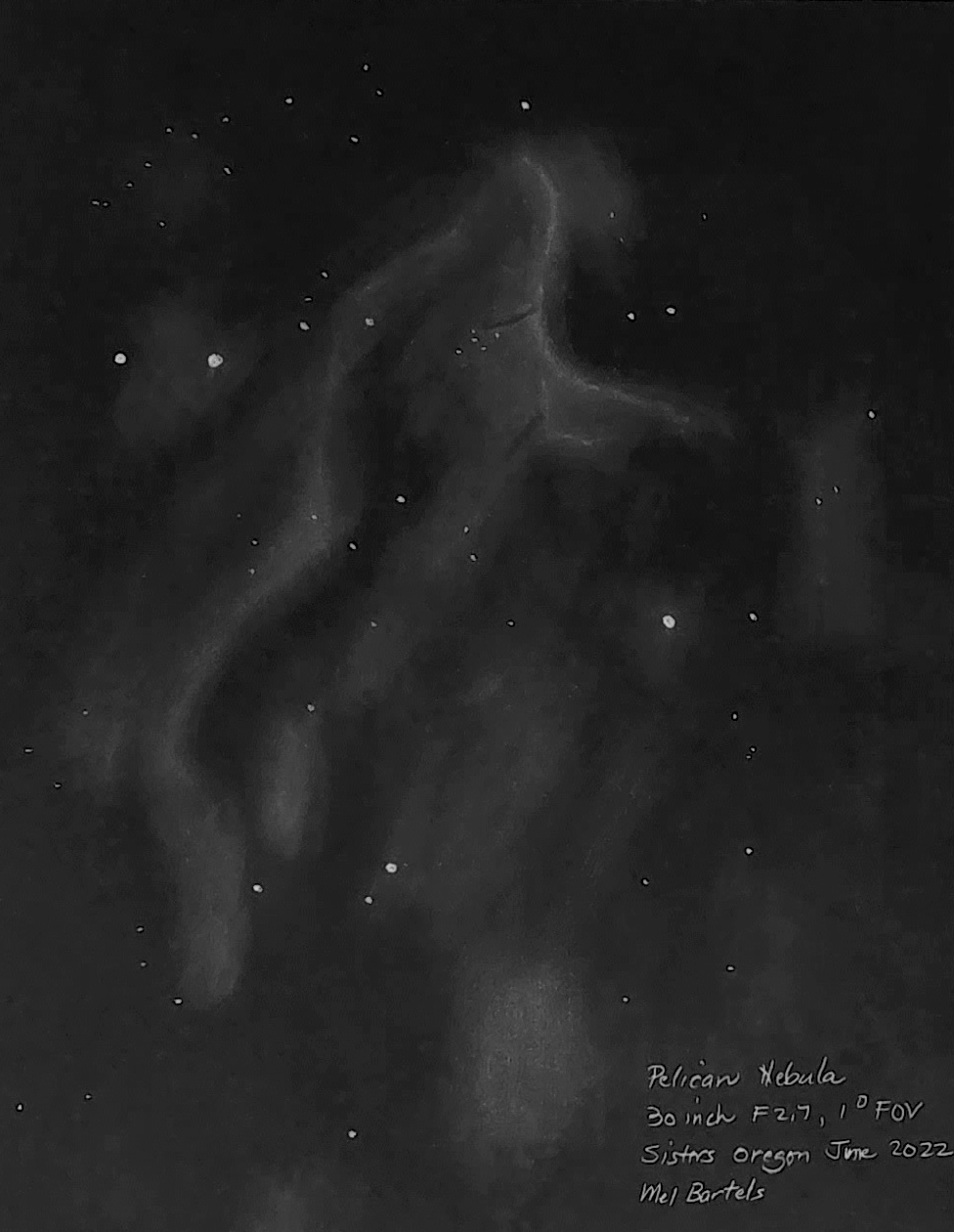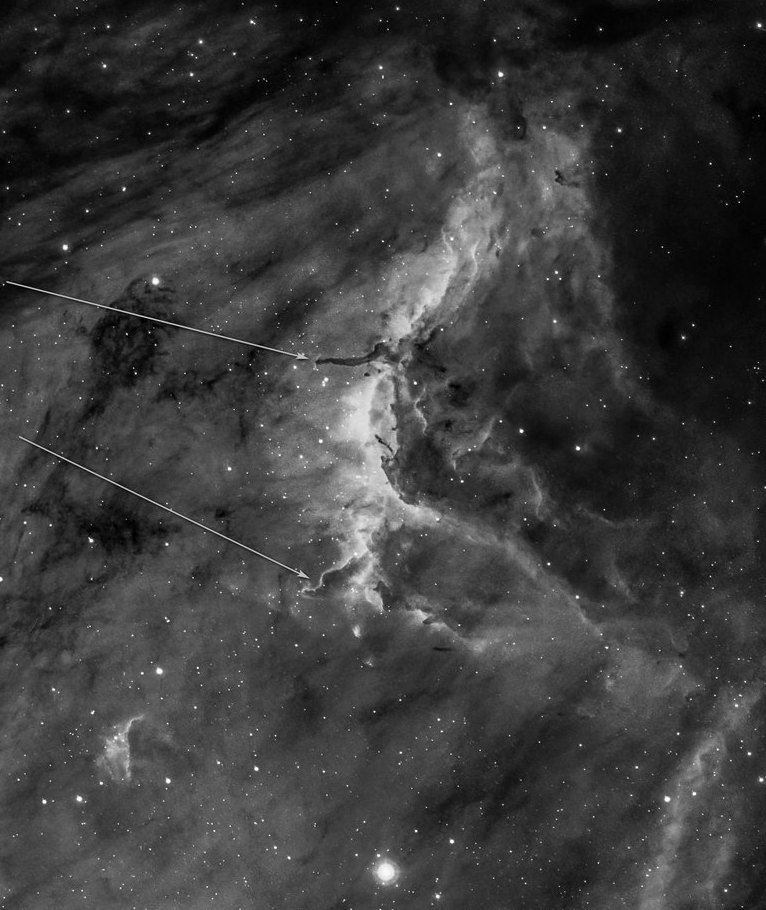What is a meniscus mirror?
A telescope meniscus mirror is a constant thickness mirror where the backside has the same curvature as the front side. My 16.25x3/8 inch mirror (image by Barbara Bajec), Larry Sharper's ultra-thin meniscus (image by Pierre Lemay)
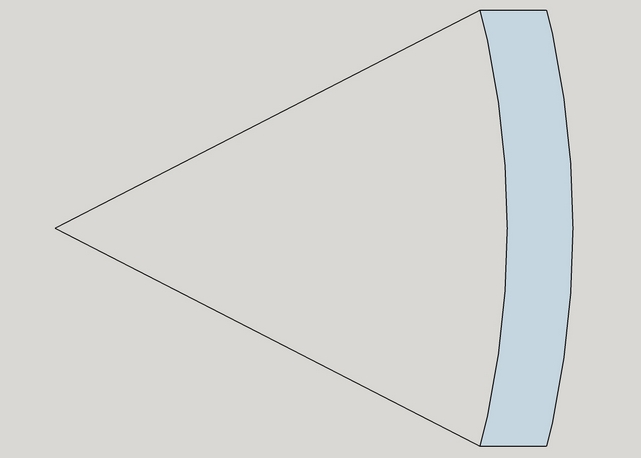


Why a meniscus mirror?
No hogging out the curve; constant glass thickness; thinner faster larger mirrors
The meniscus shape allows us to have a constant thickness mirror from mirror edge to center. A large fast mirror requires a huge sagitta, or depth in the mirror's center. I've ground curves into common flat mirrors ending up with a measly 1/4 inch [6mm] or less of center thickness. That's concerning.
Slumping a flat mirror in a kiln over a precision refractory mold into a curved shape takes the place of rough grinding in a curve. The amount of glass removed grinding in the curve for a standard flat blank 30 inch [76cm] F2.7 is about 250 cubic inches. That's the same volume as a full thickness 12.5 inch [32cm] mirror blank. Imagine grinding down such a big chunk of glass until nothing remains!
 completely grind away this volume of glass->
completely grind away this volume of glass->

John Wall, inventor of the Crayford focuser, ground a 48 inch diameter x 1 inch thick [122x2.5cm]. Perhaps if the blank had been slumped, he would have chosen a focal ratio faster than F8. Here the mirror is being polished with a sub-diameter tool.
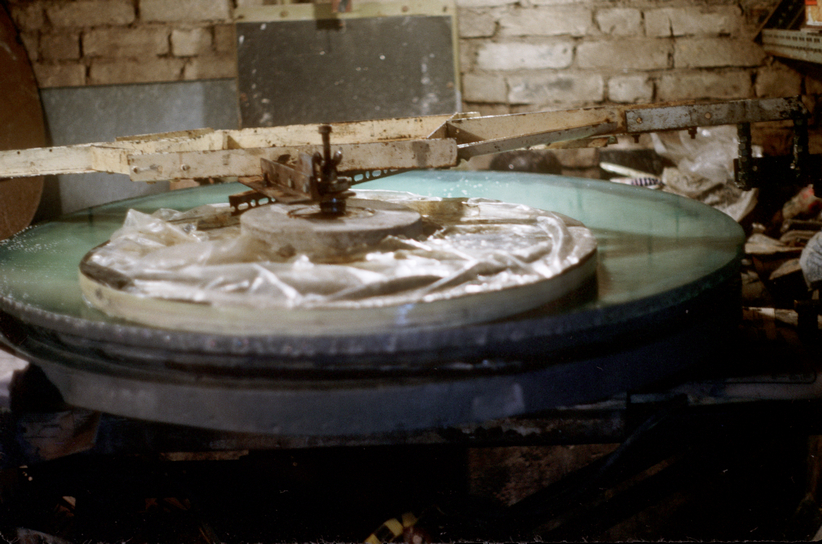
My 30x5/8 inch [760x16mm] F2.7, ready for the night. It's a no-ladder scope.
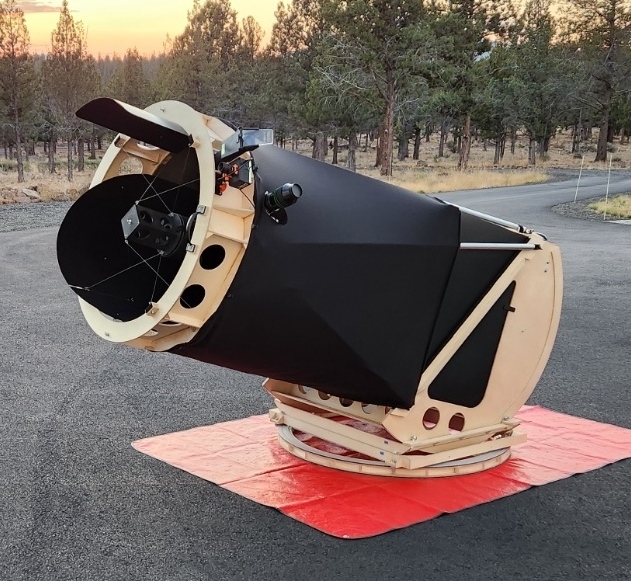
Instant or near instant thermal equilibrium
Last night (Feb 1, 2023) I heard that the comet 2022 E3 ZTF was breaking up. High clouds, patchy snow and ice on the ground. I picked up my 16.25 inch [41cm] F2.9 scope that weighs 25 pounds [11kg], carried it outside, sitting it down in an open area. As soon as I uncovered the mirrors, I was observing at my highest possible magnification. No cooling period needed; good star images. I could have rolled out my 30 inch [76cm] F2.7 that weighs a 100 pounds [45kg] and sets up in five minutes, but there wasn't a clearing large enough. That's what large thin fast meniscus mirrored telescopes offer: lots of aperture, sit down no ladder eyepiece height, lightweight transport, quick setup with no cool down needed. And the comet breaking up? A false report from someone who's tracking failed.
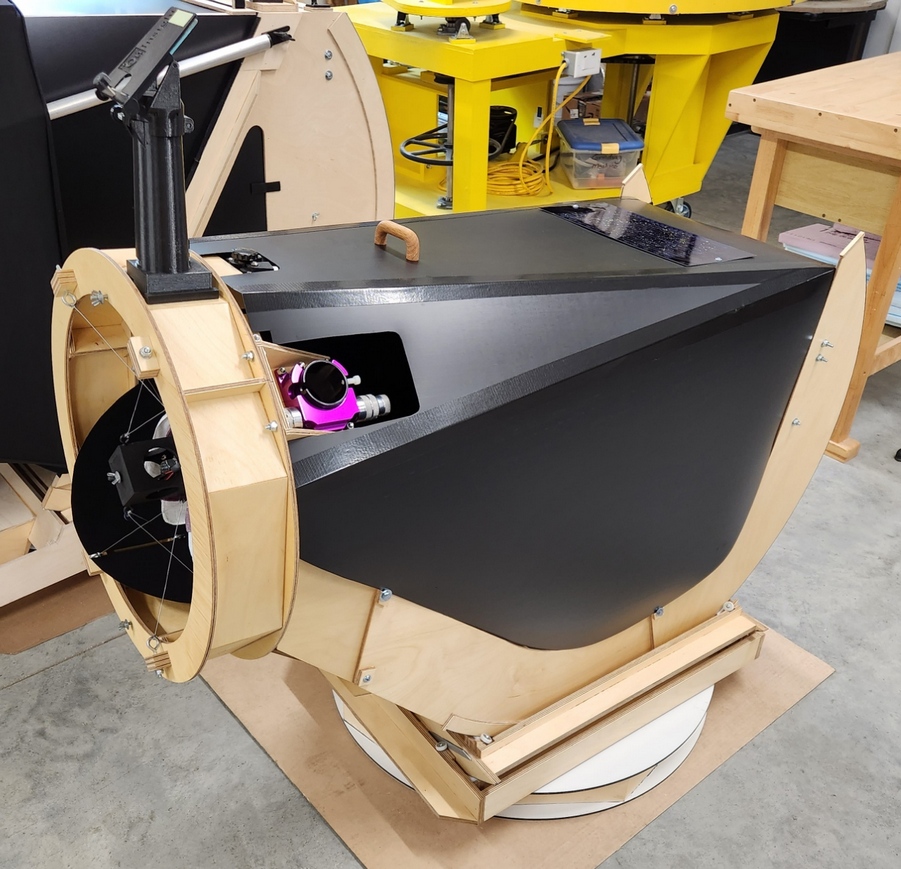
Where did the meniscus mirror idea come from?
I first thought of meniscus mirrors when looking at slumped cellular mirrors circa the year 2000. The face plate is a constant thickness slumped piece of glass, typically 1 inch [2.5cm] thick, that is fused to the cellular structure. I reasoned that the slumped face plate sans cellular support structure might work as a mirror. I obtained a 13.2x1 inch [335x25mm] F3.0 slumped mirror blank. Not only was I able to parabolize the mirror to a high degree of accuracy, but the first light views through my ZipDob revealed a new world of visual observing.
Does the meniscus shape have an antecedent in the amateur telescope making world?
Yes, in the guise of optical windows for Maksutov telescopes, popularized in the amateur telescope making world by the Maksutov Club Circulars first appearing in 1957, and by the subsequent book, "Advanced Telescope Making Techniques Volume 1 Optics" by Allan Mackintosh, 1977. Lawrence Braymer's 1954 Questar telescope featured a meniscus primary mirror. Conical shaped mirrors have a long history and are found in modern Schmidt-Cassegrain amateur telescopes. Conical mirrors that are center stalk supported sag into a close paraboloidal approximate, making them worth serious consideration.
Do meniscus mirrors have to be thin?
No, a meniscus mirror can be any thickness.
- The thinner the lighter the mirror. The lighter the mirror, the lighter the telescope. The lighter the telescope, the more likely it will be used. The difference in weight is significant: my 16.25x3/8 inch [410x10mm] F2.9 weighs 7.5 pounds [3.5kg]. Conventional mirrors of the same size weigh 30 pounds [14kg] or more. This makes a difference while grinding, polishing and parabolizing the mirror too. And during subsequent handling.
- Thinner mirrors cool down more quickly and more evenly compared to standard mirrors that are thin in the center and thick at the edge. Though very large very thin meniscus mirrors are sensitive to temperature differences between their front and back sides.
- Thinner mirrors are harder to support during grinding, polishing and parabolizing and harder to support in the telescope. Harder, not impossibly difficult at all.
Do meniscus mirrors have to be fast?
No. I call mirrors with a focal ratio of F3 or below 'fast'. A meniscus mirror can be any focal ratio.
After the success of my first meniscus mirror, then the success of my second meniscus mirror, a 10.5 inch [267x19mm] F2.7, I chose to work with fast thin meniscus mirrors. I use three-fourths inch [19mm] thick plate glass, commonly available as glass table tops and quite inexpensive.
Fast mirrors favor wider fields. And maximize etendue. Results with these fast meniscus mirrors speak for themselves. Just a few of my many examples include my (re)discovery of the Pleiades Bubble, Integrated Flux Nebula (IFN) or galactic cirrus and tidal streams in far away galaxies.
How does your thin meniscus 25 inch [64cm] mirror compare to John Dobson's 24 inch [61cm] f6.5 porthole made fifty years ago?
My mirror differs little. Here is a comparison:
- Diameter: both mirrors are 25 inches diameter; John's was stopped down to 23.5 inches to hide a rolled edge.
- Center thickness: my mirror is 5/8 inch while John's was 1/2 inch, a little thinner but not by much.
- Edge thickness: my mirror is 9/16 inch which John's was 3/4 inch, a little thicker but not by much.
- Glass shape: mine is meniscus or constant thickness with a curved backside while John's had a flat backside.
- Both mirrors were made from plate glass.
- Back support system: John used an 18 point support while mine uses nine compliant rings designed to blunt the bending and shearing that occur at the support points, much like an 18 point support uses six triangles.
- Lateral support is quite different: mine uses two points at 90 degree separation while John used a sling.
- The broad goal is the same, namely to explore the universe.
- I slumped my mirror to obtain the front curve while John ground his with carbo grit.
- I used a machine to polish my mirror while John used his muscles to polish by hand.
- My mirror favors wide fields, John's was more suited to higher magnifications.
- Mine features on the ground observing often sitting in a chair while John's required a tall orchard latter.
Who made the first thin meniscus mirror?
The first ultra-thin meniscus mirror that I saw was made by David Davis in 2005. His mirror really turned my head, a 16.25 x 3/8 inch [41x1cm] thick slumped F3. The mirror was supported on a bed of compliant 1/4 inch diameter heads that looked like marshmallows arranged in a grid. The regular figure with complete absence of astigmatism was astonishing. Here is David on the Oregon Star Party Telescope Walkabout.
Also check this out 30 inch that is 1/2 inch thick, made in 1991 by E. Arthaud of France.
Do I need a kiln?
Tom Otvos acquired a kiln, slumped a flat piece of glass, ground, polished and parabolized his mirror. Then built the telescope. So did David Davis. Monumental efforts for sure. You do not have to go that far. We've acquired 16 inch [41cm] slumped mirror blanks from DOTI.
What's so special about fast thin meniscus mirrors?
- A thinner constant thickness mirror able to be highly curved.
- A lighter weight mirror leading to a lighter weight telescope.
- Low power super wide angle views (thanks to coma correctors) emphasizing etendue, leading to visual discoveries.
- More aperture stuffed into a smaller form factor. No-ladder viewing for scopes up to 30 inches in size.
Whoa - what's this strain in the polarization test?
Actual images from Rob Brown (16 inch - note that this image also shows stress birefringence induced by edge contact). This mirror is sufficiently annealed.

Aren't meniscus mirrors unconventional?
Sure they are.
Unconventional thinking
- Leads to creativity, new ideas and innovation
- Unconventional individuals are key to innovation success, not conventional science and engineering
- Breaks free from established patterns of thinking
- Takes time to iterate until something new emerges
- Takes courage and can be a lonely pursuit
For me, meniscus mirrors are part of a larger unconventional strategy aiming for unconventional views through the eyepiece of ever more ergonomic and usable telescopes. Here is a partial list of unconventional features that I use.
- Slumped meniscus shaped mirrors made from plate glass that are fast and thin, ranging in size from small to very large
- New mirror making and testing methods
- Optical tube assembly optimizations such as single upper rings with tighter tube diameters, integrated mirror cell and mirror box assembly, smaller diagonals made possible by accepting a tiny bit of P2 coma corrector intrusion
- Wire spiders
- Collimation is built into the tube assembly, eg, focuser and diagonal alignment is built-in, there are no diagonal adjustments, I do not tweak alignment at the eyepiece
- Lightweighted structures using a skin and rib design
- TriDobs and folding ZipDobs
- 3-axis mounts using double flex rockers
- Favoring low magnification wide angle views that have led to discoveries of IFN/galactic cirrus, the Pleiades Bubble, the Andromeda twist, et al
- Executing my own low light experiments, building on Blackwell's WWII study
- Etendue along with diffraction as an explanation of visual performance
A question of quality?
Do large diameter meniscus mirrors work?
Yes. The proof is in the views and ergonomics.
As a founding member of the Altaz Initiative group whose aim is to make 1-2 meter scopes an order of magnitude cheaper, I decided to investigate ever larger curved cellular mirror face plates. I reasoned that at some point, the thin meniscus mirror will prove impractical. What is the largest thin meniscus telescope mirror that can be made by an amateur using ordinary means?
The 16 inch was a joy to make, taking a couple three months. It just works. The 25 and 30 inch took much longer to make and are more temperamental when observing with their thermal issues. Nonetheless, these mirrors show me sights in the sky I would not have imagined.

What are your results?
I contend that the value of a telescope is in the observations made. While specs are important in making the scope, it is the view through the eyepiece or the value of the digital image that counts.
I have made countless drawings. You can find them here:
- 30 inch F2.7 3-axis initial drawings
- low and high power drawings with the 25 inch F2.6 3-axis scope
- 16.25 inch F2.9 3-axis drawing of the newly discovered M31 OIII cloud
- Herschel's Ghosts, observing Integrated Flux Nebulae
- drawings at the eyepiece
- Observing dark nebulae
Comparing a meniscus to a flat back mirror
Ronchi unwrap tests of one of the 30x5/8 inch [760x16mm] F2.7 mirrors and my old 24x1 1/8 inch [610x29mm] F5.5. Both mirrors tested horizontally while supported by a 18 point back side flotation system and a sling for the edge support. The 24 inch's center thickness is 27/32 inches [21mm].


What about small meniscus mirrors?
The smallest meniscus mirror that I have made is the 10.5 inch [27cm]. I made a smaller fast mirror, a 6 inch [15cm] f2.8, from a standard thickness Pyrex blank. It makes little sense to slump smaller mirrors. The weight of a standard thickness blank is light enough and the sagitta or center depth is minimal.
How flexible are thin meniscus mirrors?
Quite flexible. The meniscus shape gives it an overall stiffness, but when considering bending and shear from a point to a nearby point, there is no difference compared to a flat backed mirror.
Here is a chart from my webpage on the 30 inch
| description | diameter | thickness | R/e | R^4/e^2 | mirror cell design | edge support |
|---|---|---|---|---|---|---|
| my 6 inch F2.8 Pyrex | 6 | 1.00 | 6 | 81 | 3 pts | 2pt @90deg |
| my 8 inch F6 | 8 | 1.125 | 7 | 202 | 3 pts | 3 pt |
| my 10.5 inch F2.7 meniscus | 10.5 | 0.75 | 14 | 1351 | 3 pts | 2pt @90deg |
| my 13.2 inch F3.0 meniscus | 13.2 | 1 | 13 | 1897 | 3 pts | 2pt @90deg |
| my 20.5 inch x 2 inch thick F4.8 | 20.5 | 2 | 10 | 2760 | 9 pts | 2pt @90deg |
| my Dobsonian 16 inch F5 portholes | 16 | 1 | 16 | 4096 | carpet or 9 pts | sling |
| my 24 inch F5.5 | 24 | 1.4 | 17 | 10580 | 18 pts | sling |
| my 30 inch F4 Pyrex sheet glass | 30 | 2 | 15 | 12656 | 18 pts | sling |
| my 16.25 inch F2.9 meniscus | 16.25 | 0.4 | 40 | 25600 | 6 pts | sling |
| John Dobson's 24 inch | 25.5 | 1 | 26 | 26427 | 18 pts | sling |
| Steve Swayze's 40 inch F5 | 40 | 2 | 20 | 40000 | 27 pts | sling |
| my 25 inch F2.6 meniscus | 25 | 0.56 | 44 | 77160 | 9 rings | 2pt @90deg |
| my 30 inch F2.7 meniscus | 30 | 0.63 | 48 | 127551 | 18 pts | sling or central hub |
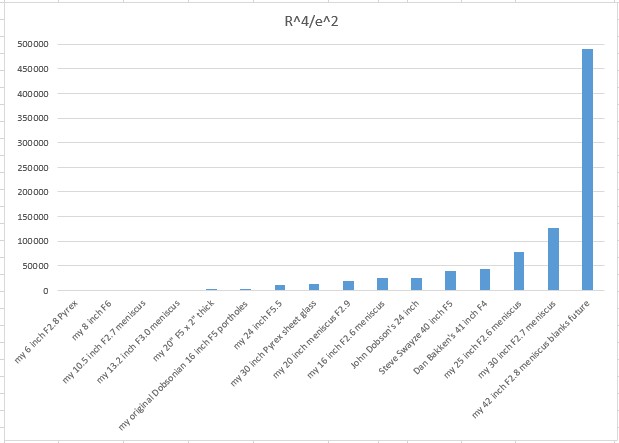
- We can use this to our advantage while parabolizing to preferentially polish down high zones.
- But we have to be careful to support the mirror on the test stand as if it were in the telescope.
- And we have to use very good technique when grinding, polishing and parabolizing these thin mirrors. For example, I use mirror on top of full sized pitch lap, carefully controlling the rotation of the pusher mechanism, the mirror and the tool.
Does the backside of a meniscus mirror need to be ground?
Probably. There is often wedge (one side of the mirror is a few thousands of an inch [0.1mm] thicker than the other side). This can lead to low order astigmatism (the thinner portion of the mirror blank flexes a tiny bit more than the thicker portion).
We've also discovered that if the backside is ground, then it should be fine ground through at least 220 grit. See the discussion on stress in my 16 inch mirror log, steps #1 and #2.
How do you design the mirror cell?
Just like a standard mirror cell, except that the supports (either flotation or astatic) must take into account the curvature of the mirror's back. The edge support needs to be centered on the center of gravity. Any deviation from supporting the edge at the center of gravity results in noticably deformed star test images. A sling works well, with the proviso that the sling be well designed.
Note that the edge support goes through the meniscus mirror's center of gravity by virtue of touching the mirror's back edge for the 16, 25 and 30 inch mirrors. That is, the mirror's sagitta happens to equal the mirror's thickness.
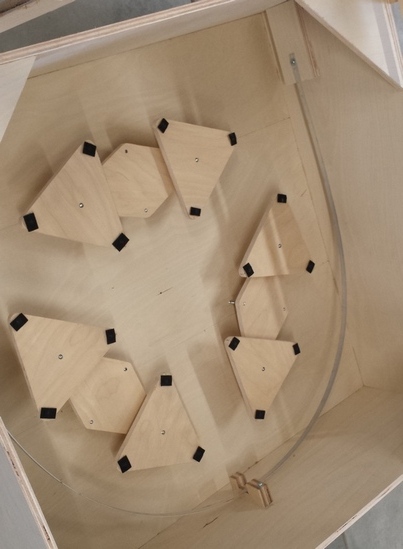
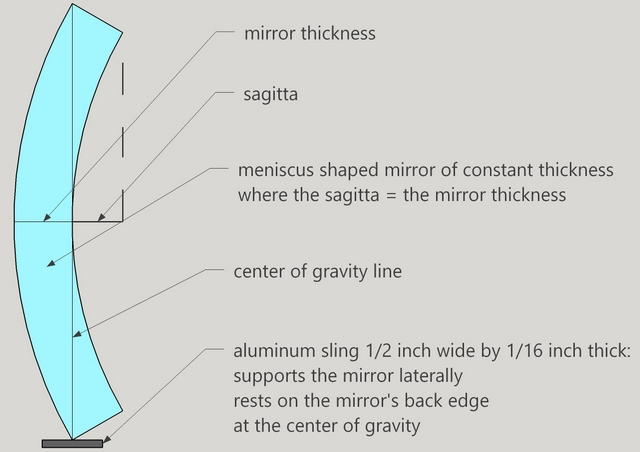
As far the edge support goes, here is R.N.Wilson's analysis from his books, "Reflecting Telescope Optics I and II"
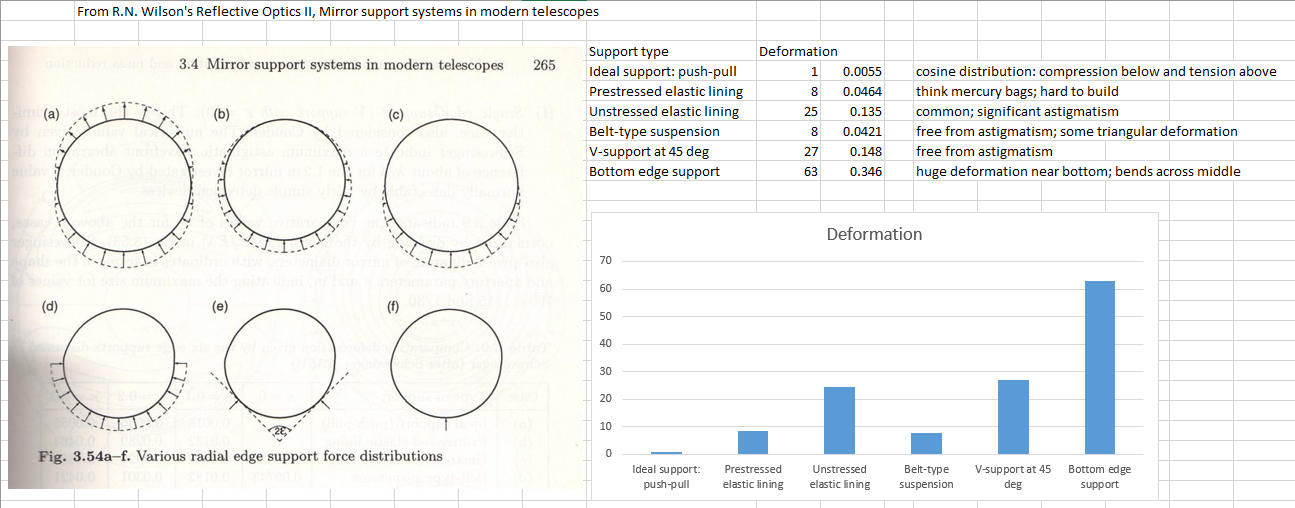
Do larger aperture have thermal issues?
Yes.
As anticipated with something new, there are surprises. Reality is not a perfect fit with speculation. Only by building do we know; only by iterating do we solve. As it turns out, the thinness of the mirrors is not a major obstacle, not even the extreme parabolization.
- The 30 inch thermal discussion
- Howard Banich's 30 inch. Search for 'thermal'.
- The 25 inch thermal discussion (open up the update after a using the scope for a year, then scan down a few paragraphs)
- The 16.25 inch has no thermal issues with the enclosed rigid shroud and sealed mirror box
If considering a very large meniscus plate glass mirror, be prepared to wrestle with thermal issues. Since this is 'engineering', it is likely that this will be solved then standardized just as thermal issues with previous mirrors were.
I hear that you only use your thin meniscus mirrored telescopes at low magnifications, implying a lack of optical quality. Is this true?
No.
I use my telescopes at the maximum power afforded by my eyepiece collection. Less maximum magnification than an equivalent F5, but adequate.
Here are high magnification examples.

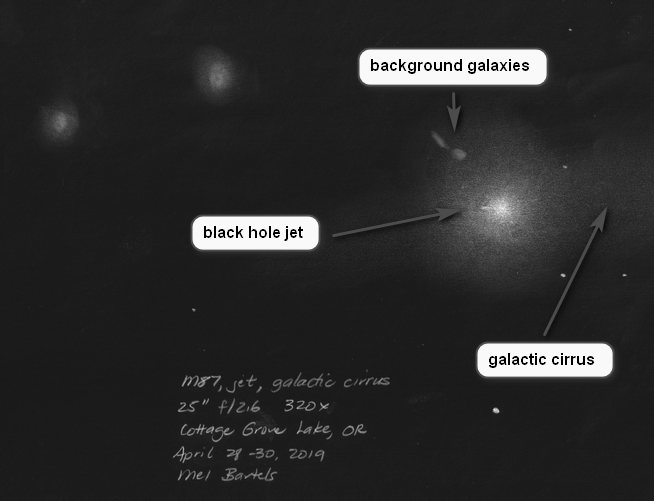
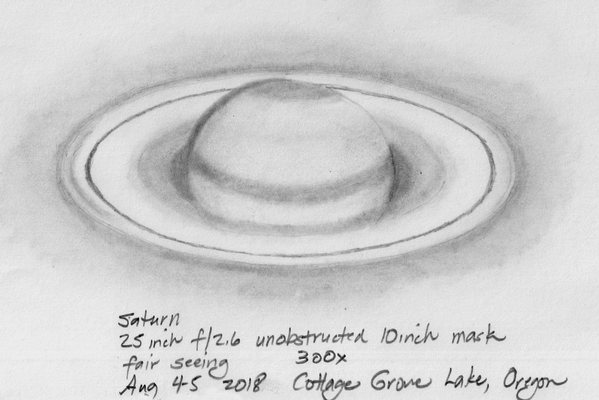

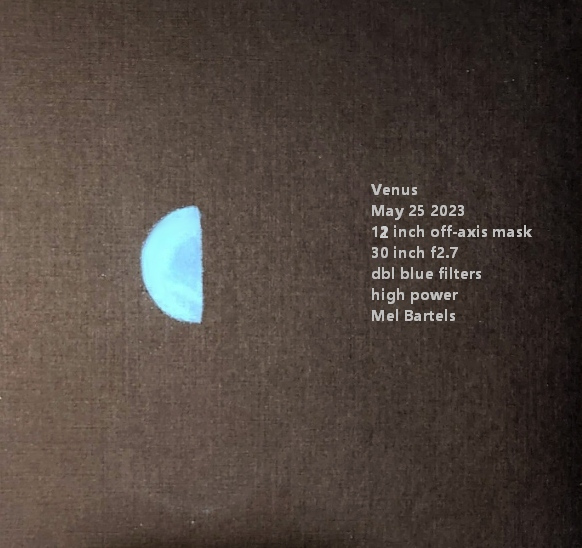
How many thin meniscus mirrors have you made?
Six, all F3 and faster and 1 inch and thinner.
| Diameter (inches) | Thickness (inches) | Focal ratio | Mirror weight (pounds) | Mirror blank source |
|---|---|---|---|---|
| (two) 30 | 0.63 | 2.7 | 38 | David Davis |
| 25 | 0.56 | 2.6 | 25 | Greg Wilhite |
| 16.25 | 0.4 | 2.9 | 7 | DOTI |
| 13.2 | 1 | 3.0 | 12 | Richard Schwartz |
| 10.5 | 0.7 | 2.7 | 5 | Richard Schwartz |
